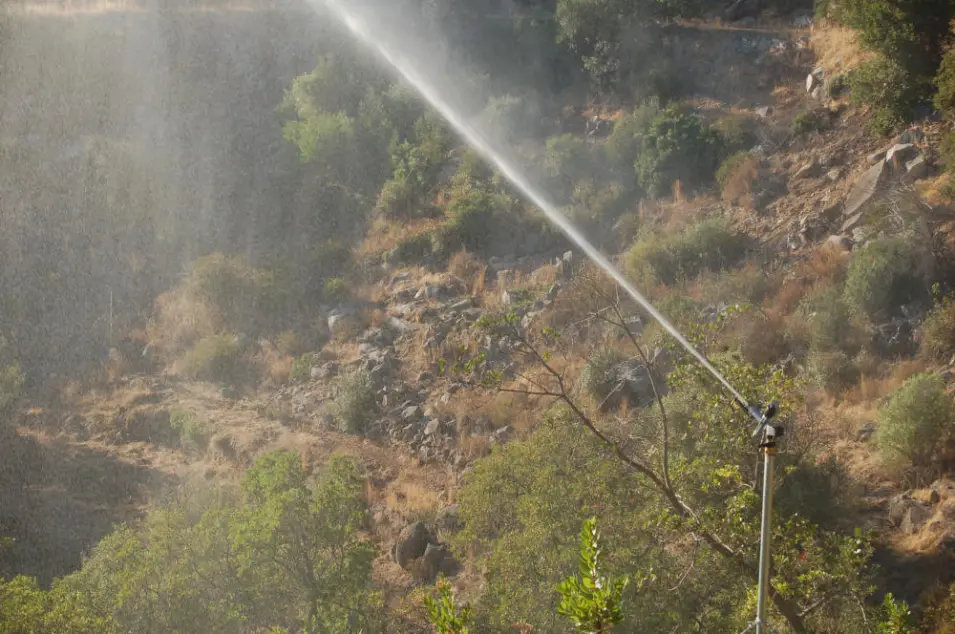Saturday, 7th december 2024.

There are people and there are people: some help; others put obstacles in the way. Such as high-voltage power lines.
A few days ago, an employee from e-redes, the former EDP electricity supply company, came to visit us in Caldas de Monchique, and she had brought a photo of an umbrella pine in her briefcase. It was the 120-year-old umbrella pine from our botanical garden, which has survived all the forest fires so far, including the last one in 2018. I had stood next to it with a garden hose and extinguished the fire all around it.
“Unfortunately, we have to cut down the tree,” she announced, because it is too close to a high-voltage power line. Now that’s the thing about high-voltage power lines in Portugal: they are not laid underground, as is the usual practice in modern European countries, but are suspended unceremoniously at a height of 12 to 14 metres above ground. Well, the umbrella pine existed long before the high-voltage power line, as it was planted back in 1904, when there were no power lines in Monchique. In keeping with the good old traditions, I ask the lady which is more important: a high-voltage cable; or a 120-year-old tree that converts many tons of CO2 into oxygen every year?
And, anyway, if a law stipulates that the cable and the tree must be at least seven metres apart, then you could also move the pylon and the high-voltage cable, couldn’t you? And, that way, you could save the tree.
The crown of this beautiful mature umbrella pine has been there ever since I began living in this neighbourhood, some 25 years ago, and the umbrella pine has never touched the high-voltage power line in all kinds of wind and weather, not even during a hurricane in 2003. It stands with its crown five metres away from the pylon and the cable, and from the trunk to the pylon there is a distance of eight metres. The law mentions the commonplace maritime pine tree (pinheiro bravo) and eucalyptus. The legislator should consult an expert botanist: such a person would certainly be able to explain to the members of parliament and e-redes the differences between an umbrella pine (pinheiro manso) and a maritime pine (pinheiro bravo); and they would also be able to outline the habits of these trees, in contrast to those of imported, non-native trees, such as eucalyptus. This is because eucalyptus is a non-native tree species that sways back and forth with the slightest gust of wind and could touch the power lines at any time, causing a massive short circuit. An umbrella pine, however, does not sway and the tons of wood that compose it are firmly anchored in the ground via the roots and do not bend with the trunk. It is also a completely different type of tree. You should know that before you send out the tree felling squad.
I am now obliged by e-redes to take responsibility for this decision and to fill out a form and sign it. What do I do? Our co-operative has recently installed a water pipe in the immediate vicinity of the tree and an extra high-pressure sprinkler, so that any fire can be extinguished immediately if, contrary to expectations, the high-voltage power line does start a forest fire. Nevertheless, in these times of climate crisis and forest fires, I ask myself whether old and valuable native trees (120 years old) should not be given priority over an overground high-voltage power line? Wouldn’t it be useful to have a debate on this issue in parliament, of course on the understanding that our aim should always be to live as harmoniously as possible with and within nature, and to give our surrounding nature priority when making decisions? It would also help an entrepreneur like e-redes to gain greater clarity and prove that they are serious about nature conservation and the preservation of native tree species. Because not all tree species are the same. And environmental protection should not be turned into a form of greenwashing.
Download the E-redes form for review (right click -> save as
Incidentally, I performed a test this year. The thermometer (in summer) in Caldas de Monchique showed a temperature of 35º Celsius at midday on 15 August 2024; I then moved with my thermometer into the shade of this 120-year-old umbrella pine tree and measured only 27º Celsius there. Forests and trees protect our climate and forest fires destroy it. The absolute goal of legislative policy should be to prevent forest fires. But how? Shouldn’t native tree species be given absolute priority over high-voltage power lines? Shouldn’t the cables be laid those seven metres away from our old umbrella pine?
This is, of course, a matter of opinion. What do you think? Write to me at editor@eco123.info with your valuable and important opinion.
 Eco123 Revista da Economia e Ecologia
Eco123 Revista da Economia e Ecologia



